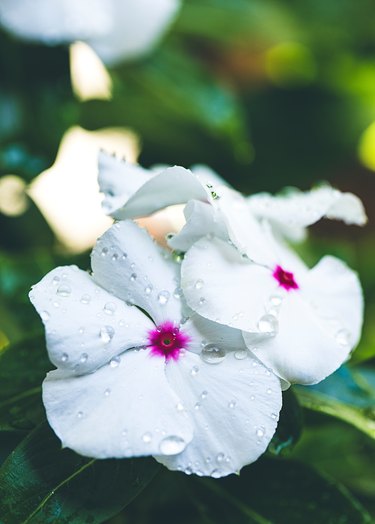
A misting system, like a rainstorm, cools the surrounding air, but because mist consists of fine drops that quickly disappear, it won't soak your clothes or your plants the way rain does. You can install high-end misting systems in your yard that use a pump to create high-pressure mist that quickly evaporates, or make your own system that works on standard water system pressure. All you need for a low-pressure system is PVC pipe, fittings and misters. The best misters for this application come with their own PVC coupler that you simply glue onto the pipes.
Misting Systems Overview
Video of the Day
Vaporization is an endothermic reaction in which energy is drawn from the environment to break the bonds between water molecules. The energy comes from the surrounding air, which turns noticeably cooler as water evaporates. This simple phenomenon, which humans employ when they sweat, is also the one behind air conditioning, although air conditioners employ refrigerant liquids other than water. The cooling that a misting system provides depends on the ambient temperature and humidity, but in exceptionally hot, dry weather, it could be as much as 30 degrees.
Video of the Day
An effective misting system is usually mounted 8 to 10 feet above the ground. It could be attached to a patio overhang, the top rail of a tall fence, or on a network of trellises and other supports. The first step in designing one, therefore, is to plan the route for the pipes and determine how to mount them. In most cases, you can fasten them with standard pipe hangers.
Choosing Misters – The market is replete with misters of different designs, but many of these are intended for use with a high-pressure pump. For a low-pressure PVC system, you need misters that operate at pressures in a range from 50 to 70 psi. Misters are somewhat like sprinklers, with a spray nozzle and a threaded base that screws into a fitting. It's important to buy the fittings – typically 1/2-inch PVC couplers – when you buy the misters, because it's difficult to avoid leaks when you install the misters directly into the pipes.
Installing a PVC Misting System
After you've determined the route for the pipes, measure the total length and purchase sufficient 1/2-inch PVC pipe to span it. You'll also need fittings, such as elbows and tees, as well as the misters themselves. Purchase enough misters to install them at 24-inch intervals.
Step 1: Cut the Pipe Into Sections
Use a hacksaw or, preferably, a PVC pipe cutter to cut the pipe. If you use a hacksaw, deburr the edges of the pipe with a file or sandpaper prior to gluing the fittings. Not deburring is needed when you use a pipe cutter.
Step 2: Glue the Mister Fittings
Clean the ends of the pipes and the insides of the fittings with PVC primer; then glue in the fittings with PVC cement. Keep track of the direction of each mister as you glue on the fitting. When you've finished, all the misters should be facing in the same direction.
Step 3: Hang the Pipes
Use pipe hangers to support the misting pipe. Nail one or two hangers loosely to support the pipe; then set the pipe in place, adjust it so the misters are at the 5 or 7 o'clock position – not straight down – and drive the fasteners to tighten the hangers. Install more hangers at 24-inch intervals to prevent sagging.
Install pipes that run perpendicularly separately; then connect them with elbows once they are in place.
Step 4: Install a Drain Fitting
Terminate the mister pipes with a female threaded adapter into which you can screw a plug. You can simply remove this plug when it's time to drain the system.
Step 5: Connect the Water
Extend the pipe to a convenient spigot and connect it. The best way to do this depends on the configuration, but in most cases, you can screw a hose-thread-to-pipe-thread adapter onto the spigot, screw on a slip adapter and glue the pipe to that. It's a great idea to first install a multi-port adapter onto the spigot so you can still use it for your garden hose.
Step 6: Test the System
Turn on the water and check each mister for leaks. When you notice one, tighten the mister into the fitting to stop it.